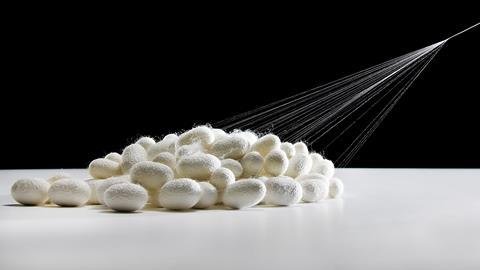NEW DELHI (India CSR): The Government of India is advancing the sericulture industry through the Silk Samagra-2 scheme, allocating Rs. 4,679.85 crore from 2021-22 to 2025-26. Aimed at comprehensive development, the scheme has disbursed Rs. 1,075.58 crore to states, benefiting 78,000 stakeholders. Financial aid supports pre-cocoon and post-cocoon activities, including silkworm rearing, seed production, and silk processing. Andhra Pradesh and Telangana have received Rs. 72.50 crore and Rs. 40.66 crore, respectively, over the past three years.
Alongside, the Raw Material Supply Scheme and National Handloom Development Programme promote the handloom sector with assistance for raw materials, looms, and marketing. Research efforts further enhance silk productivity, supporting the goal of a self-reliant India, as stated by Shri Pabitra Margherita in the Rajya Sabha on April 1, 2025.
Under Silk Samagra-2, financial assistance is extended to states for critical interventions such as raising kisan nurseries, silkworm rearing packages (including plantation, irrigation, rearing houses, equipment, and prophylactic measures), and establishing chawki rearing centres.
The scheme also supports infrastructure for the silkworm seed sector, as well as silk reeling, spinning, weaving, and processing in the post-cocoon phase. To date, Rs. 1,075.58 crore in central assistance has been disbursed, benefiting approximately 78,000 stakeholders nationwide.
The scheme has made significant strides in states like Andhra Pradesh and Telangana, with Rs. 72.50 crore and Rs. 40.66 crore allocated respectively over the past three years, including the current fiscal year. These funds have supported beneficiary-oriented components, enhancing the sericulture ecosystem in these regions.
In addition to Silk Samagra-2, the government is promoting the handloom sector through the Raw Material Supply Scheme (RMSS) and the National Handloom Development Programme (NHDP). These programs provide financial aid to handloom agencies and workers for raw materials, upgraded looms, solar lighting, workshed construction, product diversification, and marketing efforts both domestically and internationally.
| Aspect | Details |
|---|---|
| Scheme Name | Silk Samagra-2 |
| Total Outlay | Rs. 4,679.85 crore |
| Duration | 2021-22 to 2025-26 |
| Central Assistance Disbursed | Rs. 1,075.58 crore |
| Beneficiaries Covered | Approximately 78,000 |
| Support Areas | Pre-cocoon (e.g., nurseries, rearing), Post-cocoon (e.g., reeling, weaving) |
| Assistance to Andhra Pradesh | Rs. 72.50 crore (last 3 years, including current year) |
| Assistance to Telangana | Rs. 40.66 crore (last 3 years, including current year) |
| Related Schemes | Raw Material Supply Scheme (RMSS), National Handloom Development Programme |
| Handloom Support | Raw materials, looms, solar lighting, marketing, concessional loans |
| Goal | Aatmanirbhar Bharat (self-reliant India) in silk sector |
| Announced By | Shri Pabitra Margherita, Minister of State for Textiles |
| Date of Announcement | April 1, 2025 |
| Source | Rajya Sabha written reply |
***
Govt Extends ₹1,074.94 Cr Support to Silk Farmers and Weavers Under Silk Samagra-2 Scheme
Focus on self-reliance, export boost, and livelihood enhancement across silk sector
NEW DELHI (India CSR): In a significant step to strengthen the silk industry and enhance the livelihoods of silk farmers and weavers across India, the Government has provided financial assistance of ₹1,074.94 crore under the Silk Samagra-2 scheme. This support, distributed through State Governments, has directly benefited around 78,000 individuals involved in sericulture and silk weaving.
The details were shared by Shri Pabitra Margherita, Minister of State for Textiles, in a written response during the Rajya Sabha session today.
Boosting Silk Productivity and Self-Reliance
The Silk Samagra-2 scheme, which is being implemented to develop a robust and self-reliant silk industry under the Aatmanirbhar Bharat vision, aims at enhancing bivoltine silk production, improving productivity, and supporting critical field-level activities for sericulturists.
The scheme focuses on international-grade silk quality, with a targeted push toward increasing bivoltine silk output — a high-grade variety essential for both domestic consumption and export competitiveness.
Multi-Pronged Support for Silk and Handloom Workers
Apart from Silk Samagra-2, the Ministry of Textiles is also supporting silk handloom weavers through the National Handloom Development Programme and the Raw Material Supply Scheme, ensuring the availability of quality yarn and other raw materials for silk handloom workers.
These initiatives aim to address the entire value chain — from cocoon production to fabric weaving — and ensure better income opportunities for those dependent on the sector.
Vision for Global Leadership
The government’s long-term vision is to establish India as a global leader in silk production and exports. To this end, the strategy includes:
- Enhancing overall silk production
- Improving quality standards
- Investing in R&D and innovation
- Developing infrastructure for sericulture
- Expanding access to global markets
A Step Towards Empowering Rural Economy
The sericulture sector, largely concentrated in rural and semi-urban regions, offers vital livelihood opportunities for farmers and artisans. Through these strategic interventions, the government aims to empower small producers, reduce import dependence, and increase India’s share in the global silk market.
Key Highlights:
- ₹1,074.94 crore assistance disbursed under Silk Samagra-2
- Around 78,000 beneficiaries supported across states
- Focus on Aatmanirbhar Bharat through enhanced silk production
- Additional support through National Handloom Development Programme
- Push for bivoltine silk and export-oriented production
***
India’s Raw Silk Production Rises to 34,042 MT Till January 2025, Employment Touches 80.9 Lakh
Government-backed schemes fuel growth and quality improvement in sericulture sector
NEW DELHI (India CSR): India’s raw silk production has seen a significant surge in FY 2024-25, reaching 34,042 metric tonnes (MT) till January 2025, compared to 24,299 MT during the same period in FY 2014-15. This marks a substantial growth of over 40% in the last decade, highlighting the success of central government schemes aimed at revitalizing the silk industry.
The figures were revealed by Pabitra Margherita, Minister of State for Textiles, in a written response to a question raised in the Rajya Sabha today.
Central Schemes Drive Growth
The rise in silk output has been attributed to sustained support under key government interventions, including:
- Catalytic Development Programme (CDP)
- North East Region Textile Promotion Scheme (NERTPS)
- Integrated Scheme for Development of Silk Industry (ISDSI)
- Silk Samagra
- Silk Samagra-2
These schemes have provided crucial financial assistance, capacity building, and infrastructure support to farmers and silk producers, particularly in the Northeastern and southern states.
Employment Impact: 80.9 Lakh Jobs Generated
The sericulture sector continues to be a major employment generator in rural India. Based on raw silk production data up to January 2025, the estimated employment generation in the sector is 80.90 lakh, comprising:
- Direct employment: 71.2 lakh persons
- Indirect employment: 9.7 lakh persons
This demonstrates the sector’s strong socio-economic impact and its role in empowering marginal and small farmers, especially women.
Focus on Quality: 109 Automatic Reeling Machines Operational
To enhance the quality of Indian silk, the government has also promoted modern technologies. The establishment of 109 Automatic Reeling Machines (ARMs) has contributed to the production of international-grade silk of 3A and 4A quality, boosting India’s export potential.
These machines have improved efficiency and consistency in silk reeling, ensuring better returns for producers and reducing post-harvest losses.
Key Highlights:
- Raw silk production (till Jan 2025): 34,042 MT
- Raw silk production (till Jan 2015): 24,299 MT
- Employment generated: 80.90 lakh (Direct: 71.2 lakh, Indirect: 9.7 lakh)
- 109 Automatic Reeling Machines operational for high-quality silk
- Major growth attributed to schemes like Silk Samagra, NERTPS, CDP, and ISDSI
The government’s sustained push through policy support, infrastructure modernization, and employment-centric schemes is steadily transforming the silk sector. With an upward trend in both volume and quality, India is on its way to achieving self-reliance and global competitiveness in silk production.
Stay updated with India CSR News for more developments in India’s textile and rural employment sectors.
(India CSR)





